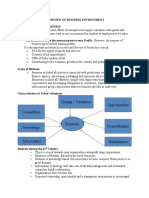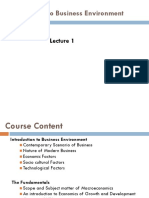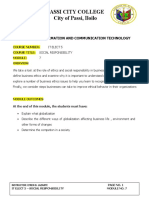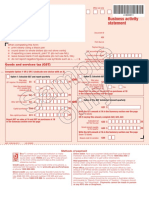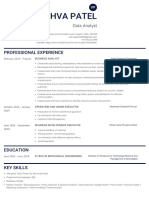Module 1notes
Module 1notes
Uploaded by
rajkrishna03Copyright:
Available Formats
Module 1notes
Module 1notes
Uploaded by
rajkrishna03Copyright
Available Formats
Share this document
Did you find this document useful?
Is this content inappropriate?
Copyright:
Available Formats
Module 1notes
Module 1notes
Uploaded by
rajkrishna03Copyright:
Available Formats
Main topic Strategic Management Accounting
Topic Value
The Role of Strategic Management Accounting
Strategic Management And Strategic Management Accounting Accounting
Evolution of Management Accounting
Causes for change in the business environment
Figure 1.5 - Causes of Change in the Contemporary Business Environment The Global Economy Financial Crisis
Structural Change Globalisation
Technology
Capital Equipment Information & Communication Technologies
Stakeholders focus corporate social responsibility Corporate Governance Ethics
Internal Structures
Offshoring and Outsourcing
Virtual Offices and Global Teams
Joint Ventures and alliances
Reaction to Change Strategic Management Accounting
Brief description Definition of Value Value creation described in Public Sector, Non Profit sectors Value creation described for Shareholders, Customers & Stakeholders Difference between Strategic Managment and Strategic Managment Accounting
Name
Page no. 1.4 1.5 1.6
1.7
Role of accounting to support decision making Decision making by management areas - Products, Supply Chain, Infrastructure, Financing & Resource Allocation Decision making by external user groups - investors, Lenders, Suppliers, Customers and Government/Public Interest Groups Difference between Financial Reporting and SMA - focus on useful reporting to support day today and strategic decision of management IFAC's traditional definition of Management Accounting IFAC 1998 Five stages of historical development of Management Accounting: Stage 1: Prior to 1950 Stage 2: 1950 up to 1965 Stage 3: 1965 up to 1985 Stage 4: 1985 up to 2000 Stage 5: 2000s to the present Activities performed by SMA External Factors: Globalisation, Increased Competition, Increasing focus on Corporate Governance & Broader Stakeholders perspective of Corporate Accountability and Developing Technology. Internal Factors: Changing structure of organisation & Decentralisation in Decision-Making
1.8 1.8 1.9 1.9 1.1
IFAC 1998
1.1
IFAC 2005
1.11 1.11
Global Economy:- Financial Crisis, Globalisation, Structural Change Technology:- Capital Equipment, Information Communication Technology Sustainability:- Environmental Management Accounting, Stakeholders, Governance, Ethics Internal Structures:- Flatter Heirarchies, Joint Ventures, Outsourcing/Offshoring, Virtual Offices Economies throughout the world are interdependent. Any changes in one economy has impact and spreads across the globe and creates panic and sends share markets tumbling. Government debt has substantially increased in most of the developed nations and is showing no sign of decrease Integration of International economic activity and creation of global production systems to service global markets Impact of globalisation. Consequences of globalisation Lasserre's four main drivers: Global competition Physical and capability factors Social factors and national cultures and Legal and political systems Different reasons for above drivers Rapid development in technology is helping to convert raw materials into finished goods in less time compared to olden days with less wastage and more efficiency. With technology rapidly changing every day products becoming obsolete within no time so investments needs to recouped in short period In present scenario technology is replacing humans so SMA is gaining lot of importance to see how value it adds to organisation like - stronger non-financial performance evaluation, ensuring compliance with external regulation and providing reality check for business proposal
1.12
1.12 1.14 1.14 1.14
Lasserre (2003)
1.15 & 1.16
1.16
1.17 1.17 1.17
CG should focus onb oth the development of performance enhancing measures and compliance with external regulations
1.12
There is a growing body of opinion that argues for greater accountability of organisations to a body of stakeholders that includes accountability for environmental and social impacts Relates to the overall framework within which an organisation is governed, and describes the interrelationships between key stakeholdrs including the board of directors, management, shareholders, creditors, customers and government Ethical implications in organisational decision-making by taking into consideration non-financial issues like OHS and Work safety issues CPA Members are expected to comply APES Code of Ethics - Integrity, Confidentiality, Objectivity, Professional Competence and Due Care and Professional Behaviour Structures incorporates the tasks, responsibilities and hierarchies given to different groupings and the authority delegated to different positions. Accounting system that are structured in functional way are called Responsibility Accounting System (RAS) RAS collects revenues and costs and are also measures performance of these responsibility - Cost Centres, Revenue Centres, Profit Centres, Investment Centres Key changes has been is reduced middle manager replacing with IT there by senior managers have direct communication with lowest employee Another change is to create organisation that are more flexible by passing information and decision between different layers of organisation Offshoring results in moving some of its activities to subsidiaries in overseas locations Outsourcing results in moving some of its activities to another organisation which might be based overseas. Many organisations have found they are very capable of in one activity but mediocre in others which why they are outsourcing non-core activities Franchising has become a popular way for both the original creators of business to accelerate their growth, and for other entrepreneurs to develop a business faster through the use of an existing brand name and business process People around the globe work on a project without meeting each other. Negative barriers are language barriers, cultural differences and difficulties in supervision. SMA tasks are: project planning, budgeting, performance measurement and reporting accross time zones and cultures.
1.19
1.20 1.2 1.2 1.21 RAS 1.21 1.21 1.21 1.21 1.22 1.22 IBM 2004, Walker 2004 1.22
1.22
Strategic alliances and joint vbentures are very popular for organisations for actively involved in new markets, products or technologies by collaborating with partners. Advantages are faster, less-costly and less-risky penetration strategies with alliance parnters Acquiring existing operating organisation is an another alternative which gives immediate results and possibly less expensive In order to achive more success globaly and in an unknown market most of the organisation involve themselves into strategic alliances and collaboration - the more they get involved the more it is likely to lose its identity within a tangle of organisations, alliances and markets
1.22 1.22 Petrella 1996 1.23
Module 1 Basalat Bhasker Gangadhar Raj Sam
Study Guide (SG) SG SG SG SG
Starting Page 22 5 30 39 13
Ending Page 29 12 38 46 21
Total pages (approx) 7 7 8 7 8
You might also like
- Practical Customer Success Management A Best Practice Framework For Rapid Generation of Customer Success by Rick Adams (Author)Document279 pagesPractical Customer Success Management A Best Practice Framework For Rapid Generation of Customer Success by Rick Adams (Author)Jorge Álamos100% (1)
- The Efficient Practice: Transform and Optimize Your Financial Advisory Practice for Greater ProfitsFrom EverandThe Efficient Practice: Transform and Optimize Your Financial Advisory Practice for Greater ProfitsNo ratings yet
- BAS Worksheet - Task 1Document1 pageBAS Worksheet - Task 1rajkrishna03No ratings yet
- MSC MA Lecture 1 OverviewDocument26 pagesMSC MA Lecture 1 OverviewAlwi Al-AidarosNo ratings yet
- The Nature of An External AuditDocument4 pagesThe Nature of An External AuditMicah AndresNo ratings yet
- Management Theory and PracticeDocument8 pagesManagement Theory and PracticeBijesh SiwachNo ratings yet
- MA 2 Psychology Change ManagementDocument28 pagesMA 2 Psychology Change Managementruhee.khan.3916612No ratings yet
- Unit 2Document35 pagesUnit 2Pallavi KapoorNo ratings yet
- IR Discussion Paper 2011 SpreadsDocument17 pagesIR Discussion Paper 2011 SpreadsJordi JaumàNo ratings yet
- Study Material For Advanced ManagementDocument5 pagesStudy Material For Advanced ManagementBinny P JohnNo ratings yet
- CP MotivatorDocument27 pagesCP MotivatorKhushi PatelNo ratings yet
- Opm 101 Chapter 1Document27 pagesOpm 101 Chapter 1Gagan KarwarNo ratings yet
- The Economic Environment: Course: ECON6017003 - ECONOMICS THEORY Effective Period: Even Semester 2022Document18 pagesThe Economic Environment: Course: ECON6017003 - ECONOMICS THEORY Effective Period: Even Semester 2022Stivon LayNo ratings yet
- Nature of Business EnvironmentDocument25 pagesNature of Business EnvironmentDheeraj KumarNo ratings yet
- 03 Intl Biz Entry Strategy Sess 5 & 6Document25 pages03 Intl Biz Entry Strategy Sess 5 & 6vishalNo ratings yet
- Assignment Strategic ManagementDocument9 pagesAssignment Strategic ManagementSarthak AroraNo ratings yet
- IPM Unit-5Document17 pagesIPM Unit-5priyankag3822No ratings yet
- Introduce To Management AccountingDocument9 pagesIntroduce To Management AccountingSagung AdvaitaNo ratings yet
- Table of ContentDocument16 pagesTable of ContentNuwan KumarasingheNo ratings yet
- Microsoft Word - F3 - Revision SummariesDocument45 pagesMicrosoft Word - F3 - Revision SummariesAnonymous keHdP6ro100% (1)
- Mark-Up Earned 670,134,034 Total Income 277,297,21 Profit After Taxation 56,855,995 EPS 38.76Document15 pagesMark-Up Earned 670,134,034 Total Income 277,297,21 Profit After Taxation 56,855,995 EPS 38.76Muhammad Owais AfzalNo ratings yet
- Strategic Management2Document9 pagesStrategic Management2shekharNo ratings yet
- Accenture CM AWAMS High Performance Asset ManagementDocument12 pagesAccenture CM AWAMS High Performance Asset Managementpearlramar100% (1)
- Dttmasteringfinanceinbusinessupdated 130921054456 Phpapp01Document32 pagesDttmasteringfinanceinbusinessupdated 130921054456 Phpapp01bobbydebNo ratings yet
- Nature of Business EnvironmentDocument26 pagesNature of Business EnvironmentPriya AroraNo ratings yet
- External Influences On Management Accounting: Unit 1 SectionDocument4 pagesExternal Influences On Management Accounting: Unit 1 SectionBabamu Kalmoni JaatoNo ratings yet
- Nature of Business EnvironmentDocument9 pagesNature of Business EnvironmentAshish PatelNo ratings yet
- Business EnvironmentDocument17 pagesBusiness Environmentkotak.rahul36No ratings yet
- Transforming Corporate Actions Processing: The Long Road AheadDocument8 pagesTransforming Corporate Actions Processing: The Long Road AheadCognizantNo ratings yet
- WEF Balancing Financial Stability, Innovation, and Economic GrowthDocument20 pagesWEF Balancing Financial Stability, Innovation, and Economic GrowthKonstantin S. TrusevichNo ratings yet
- 5 Core Business ProcessDocument6 pages5 Core Business ProcessBasnet Bidur67% (3)
- Ibe Lecture 1 IntroductionDocument16 pagesIbe Lecture 1 IntroductionFRANCISCO B. QUIACHON JR.No ratings yet
- MATLDocument26 pagesMATLmechanical mahathammaNo ratings yet
- Challenges For Financial Managers in A Changing Economic EnvironmentDocument7 pagesChallenges For Financial Managers in A Changing Economic EnvironmentFaria MehboobNo ratings yet
- Global Corporate StrategyDocument13 pagesGlobal Corporate StrategyShaji Viswanathan. Mcom, MBA (U.K)No ratings yet
- Perf ReportingDocument19 pagesPerf Reportingjohn labuNo ratings yet
- Nature of Business EnvironmentDocument26 pagesNature of Business EnvironmentPallavi JainNo ratings yet
- Ibe 1Document26 pagesIbe 1Mitika MahajanNo ratings yet
- The Performance Effect of Innovation inDocument12 pagesThe Performance Effect of Innovation inAbegail Feb SumalpongNo ratings yet
- Business SLDocument21 pagesBusiness SLjoebidet243No ratings yet
- 2.2. Business Enabling Environment: Review Basic Information On TheDocument2 pages2.2. Business Enabling Environment: Review Basic Information On TheErika PetersonNo ratings yet
- Unit4 Industry Focus Not For Profit Organizations BR190402INTDocument12 pagesUnit4 Industry Focus Not For Profit Organizations BR190402INTJAMNo ratings yet
- Week 3 - Module 1Document6 pagesWeek 3 - Module 1chris layNo ratings yet
- Introduction To Business EnvironmentDocument38 pagesIntroduction To Business EnvironmentVijay KingNo ratings yet
- AUGER Chap2 Part2and3Document7 pagesAUGER Chap2 Part2and3alexanderNo ratings yet
- Module 7Document13 pagesModule 7efrenNo ratings yet
- PESTEL Analysis & Uses in FinanceDocument9 pagesPESTEL Analysis & Uses in Financeveder20912No ratings yet
- BFN 427 - Emerging Issues in SFMDocument23 pagesBFN 427 - Emerging Issues in SFMgeorgeNo ratings yet
- 4.Business EnvironnementDocument45 pages4.Business Environnementg8bzq6j22xNo ratings yet
- PPM Us en WP Catalyst PmoDocument9 pagesPPM Us en WP Catalyst PmoMoradNo ratings yet
- 1109 Integrated Reporting ViewDocument12 pages1109 Integrated Reporting ViewbarbieNo ratings yet
- Ch01 Gone GlobalizationDocument27 pagesCh01 Gone GlobalizationFransisca LesTariNo ratings yet
- Business Policy and Strategy NotesDocument22 pagesBusiness Policy and Strategy Noteshussain shablilNo ratings yet
- External AuditDocument36 pagesExternal AuditAndrea MercadoNo ratings yet
- Winning in A Business 4 0 World PDFDocument56 pagesWinning in A Business 4 0 World PDFLap Pham100% (1)
- Non Financial InformationDocument4 pagesNon Financial Informationmeenakshi56No ratings yet
- EY Risk Management For Asset Management Survey 2013Document48 pagesEY Risk Management For Asset Management Survey 2013bharat100% (1)
- Swot Analysis of Hayleys Company LTD PDFDocument20 pagesSwot Analysis of Hayleys Company LTD PDFShehani WijayawardenaNo ratings yet
- AhmedSharkas SM1Document6 pagesAhmedSharkas SM1AhmedHassanSharkasNo ratings yet
- Environmental InfluenceDocument4 pagesEnvironmental InfluenceolmezestNo ratings yet
- Strategy, Value and Risk: Industry Dynamics and Advanced Financial ManagementFrom EverandStrategy, Value and Risk: Industry Dynamics and Advanced Financial ManagementNo ratings yet
- IT-Driven Business Models: Global Case Studies in TransformationFrom EverandIT-Driven Business Models: Global Case Studies in TransformationNo ratings yet
- Financial Reporting: Business Combinations and Group AccountingDocument17 pagesFinancial Reporting: Business Combinations and Group Accountingrajkrishna03No ratings yet
- BAS Template PDFDocument2 pagesBAS Template PDFrajkrishna03No ratings yet
- Cap GainDocument215 pagesCap Gainrajkrishna03No ratings yet
- Experience in Engineering...Document2 pagesExperience in Engineering...rajkrishna03No ratings yet
- Cultivates Productive Working RelationshipsDocument1 pageCultivates Productive Working Relationshipsrajkrishna03No ratings yet
- RL Salary Survey Report 17Document20 pagesRL Salary Survey Report 17rajkrishna03No ratings yet
- The Ability To Achieve Positive Work OutcomesDocument1 pageThe Ability To Achieve Positive Work Outcomesrajkrishna03No ratings yet
- Relevant Technical KnowledgeDocument3 pagesRelevant Technical Knowledgerajkrishna03No ratings yet
- Contract Management Experience Including...Document2 pagesContract Management Experience Including...rajkrishna03No ratings yet
- General Administrative Skills...Document2 pagesGeneral Administrative Skills...rajkrishna03No ratings yet
- Science Report Renewable House Akhila Krishna 7CDocument3 pagesScience Report Renewable House Akhila Krishna 7Crajkrishna03No ratings yet
- The Ability To Develop...Document2 pagesThe Ability To Develop...rajkrishna03No ratings yet
- Ancient Egypt and What It Was Like During The Time of Ramses II (PARAGRAPH)Document1 pageAncient Egypt and What It Was Like During The Time of Ramses II (PARAGRAPH)rajkrishna03No ratings yet
- Report - Lights, Camera, ActionDocument7 pagesReport - Lights, Camera, Actionrajkrishna03No ratings yet
- Unit Economics Calculator: Lifetime Value (LTV)Document1 pageUnit Economics Calculator: Lifetime Value (LTV)askvishnu7112No ratings yet
- Assignment Usm MGMTDocument6 pagesAssignment Usm MGMTfatysawolNo ratings yet
- Strategic Leadership Case Analysis: The Murugappa GroupDocument4 pagesStrategic Leadership Case Analysis: The Murugappa GroupKotwal Mohit KotwalNo ratings yet
- Coca ColaDocument11 pagesCoca ColaAagam JainNo ratings yet
- Kirkland OTICDocument20 pagesKirkland OTICcaselusNo ratings yet
- JOURNALSDocument2 pagesJOURNALSJD AguilarNo ratings yet
- Operations Management AssignmentDocument12 pagesOperations Management AssignmentMeghna SridharNo ratings yet
- WZZ CASM Rev 07Document123 pagesWZZ CASM Rev 07Alex RoșuNo ratings yet
- Blue Mark College: Level Iv AssignmentDocument14 pagesBlue Mark College: Level Iv AssignmentAmareNo ratings yet
- Immigrant Worker Owned Cooperatives: A User's ManualDocument78 pagesImmigrant Worker Owned Cooperatives: A User's ManualDennis Kelleher100% (3)
- دراسة العطاءات وتقدير التكاليفDocument10 pagesدراسة العطاءات وتقدير التكاليفعماد محمدNo ratings yet
- Invoice 20240210154116V500Document1 pageInvoice 20240210154116V500MadihaNo ratings yet
- SWOT Kingfisher AirlinesDocument3 pagesSWOT Kingfisher AirlinesKamal AnchaliaNo ratings yet
- Materi Cost Estimate Based On AaceDocument59 pagesMateri Cost Estimate Based On AaceMr Dyota100% (2)
- Vishva Patel Data AnalystDocument2 pagesVishva Patel Data AnalystN L P & CONo ratings yet
- Corporate PresentationDocument50 pagesCorporate PresentationAniket SabaleNo ratings yet
- BBM3017 - Entrepreneurship (Updated)Document4 pagesBBM3017 - Entrepreneurship (Updated)Trần Thuỳ NgânNo ratings yet
- Chapter 11Document44 pagesChapter 11Ishita SoodNo ratings yet
- Report Myanmar Financial Sector - A Challenging Environment For Banks Nov201Document56 pagesReport Myanmar Financial Sector - A Challenging Environment For Banks Nov201JanDaleBenavidezNo ratings yet
- Myanmar Salary Survey Report 2020 - Web 1-1Document29 pagesMyanmar Salary Survey Report 2020 - Web 1-1sayreal100% (1)
- Chapter 2Document31 pagesChapter 2Amoon Khalied100% (1)
- ACF USA Annual Report Financials 2006Document20 pagesACF USA Annual Report Financials 2006Action Against Hunger USA100% (1)
- RFQ Template - For Removal of AsbestosDocument166 pagesRFQ Template - For Removal of AsbestossalesNo ratings yet
- Buyouts Trust The Process 1723970815Document11 pagesBuyouts Trust The Process 1723970815jangloecknerfsNo ratings yet
- AF W09 - Financial Statement Fraud - ENGDocument17 pagesAF W09 - Financial Statement Fraud - ENGjokitugasbro.idNo ratings yet
- Business Planning Process: DR - Mukul MishraDocument52 pagesBusiness Planning Process: DR - Mukul Mishradrlov_20037767No ratings yet
- Buss1000 - StrategyDocument7 pagesBuss1000 - StrategyMinh AnhNo ratings yet
- NB-CPR 15-639r3Document9 pagesNB-CPR 15-639r3Ivo MišurNo ratings yet
- Analisis SWOT Terhadap Layanan Kardiovaskular Eka Hospial PekanbaruDocument20 pagesAnalisis SWOT Terhadap Layanan Kardiovaskular Eka Hospial PekanbaruTitin IndrayaniNo ratings yet


























